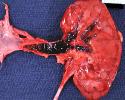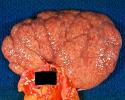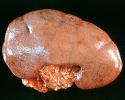


Thrombosis
Chronic
Acute

Normal
Although the use of ACE-inhibitors has significantly reduced the incidence of renal failure in patients with systemic sclerosis, kidney failure remains as a significant complication of lupus affecting about 20% of patients. Renal transplant is a potential treatment for such patients. Of course, transplantation is not without complications, and some of these are shown here (acute rejection, chronic rejection, and renal vein thrombosis).
Can you match up the gross & histologic images to the correct diagnosis? What other types of rejection are there?
In the acute cellular rejection kidney, note the edema and hemorrhage. Histologically, acute cellular rejection characterized by significant lymphocytic infiltration which attacks both the tubular epithelium and small vessels, resulting in edema and acute tubular necrosis.
In the chronic rejection kidney, you can see the granularity and scarring that are associated with fibrosis and vascular occlusion. This type of damage usually takes years to develop. The histology is characterized by patchy fibrosis, chronic interstitial inflammation, tubular atrophy, glomerular sclerosis, and vascular lesions. The vessels show fibrosis and thickening of vascular intima, similar to that seen in arteriosclerosis. Chronic rejection causes a loss of renal function and is frequently associated with hypertension and proteinuria. There are numerous risk factors for chronic rejection including: recurrent acute injury (ie, donor factors, reperfusion/preservation injury, rejection) and chronic injury (ie, long-term effects of immunosuppressive drugs, poorly controlled blood pressure, dyslipidemia, diabetes).
Renal vein thrombosis usually occurs within days of transplant. Compression of the renal vein by fluid collection, a clot from the renal vein, coagulopathy, hypovolemia, or surgical technique can cause thrombosis, requiring removal of the transplanted kidney.
Not shown is acute humoral rejection (rejection vasculitis) can occur within minutes of transplant (hyperacute rejection) or within the first week following transplant. Hyperacute occurs because the recipient has preexisting antibodies against the graft (obtained via prior blood transfusions, multiple pregnancies, or prior transplantation). The recipient can also develop an antibody response to the transplant within the week following transplant. In either case, the antigen-antibody complexes activate the complement system, causing massive thrombosis in the capillaries of the graft. In such cases the transplant must be removed.























